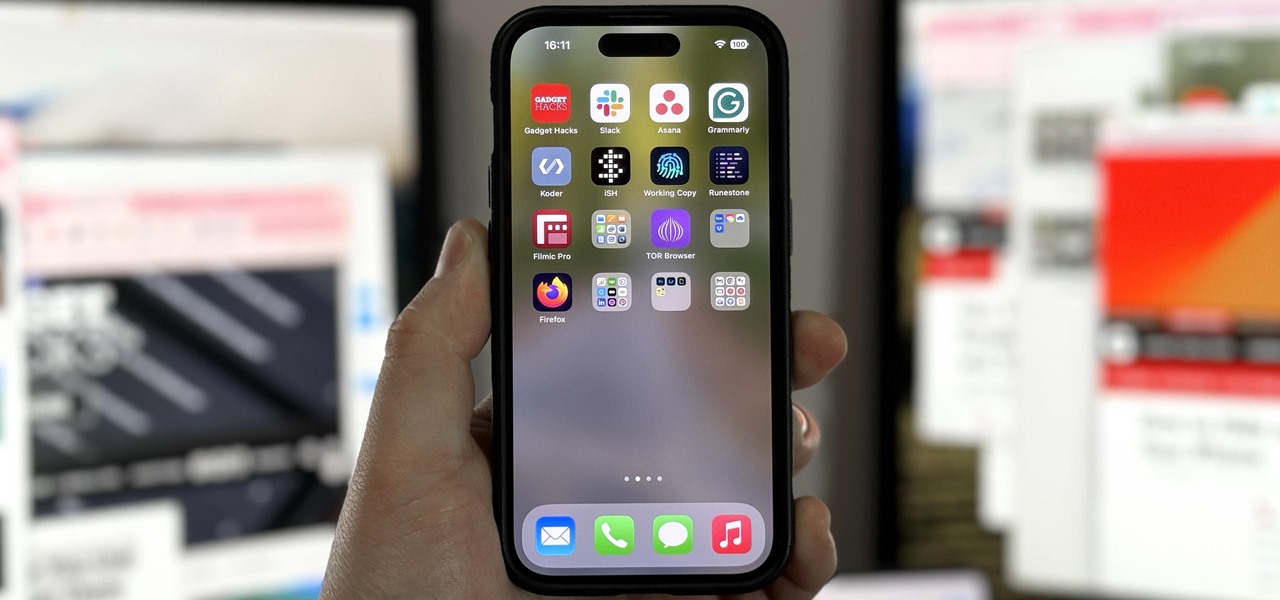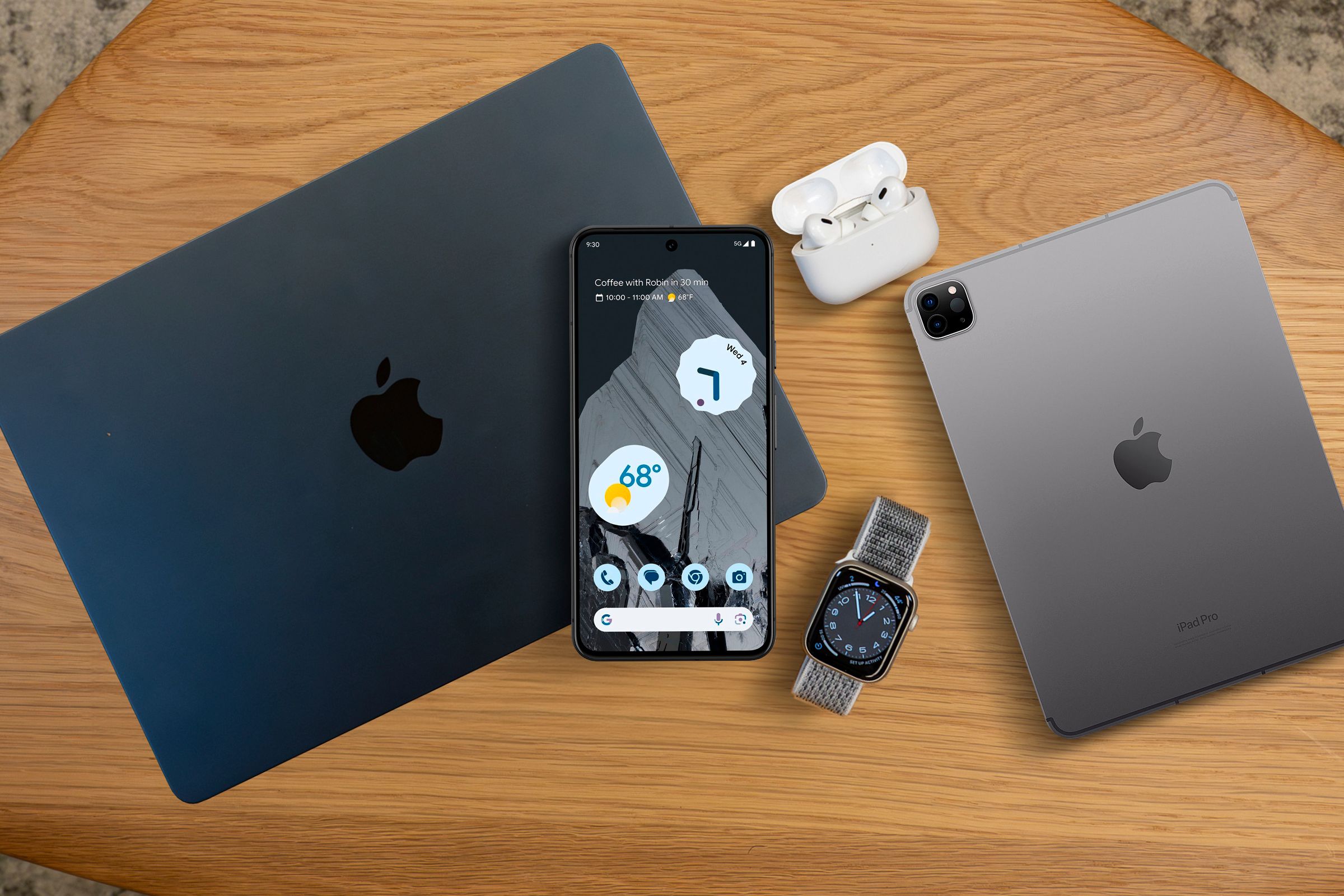Rumors about the 2022 iPhone series stirred well before the iPhone 13 models were even released. While Apple remains quiet on the next big iPhone, as it always does, we’re seeing more and more leaks and reveals for the iPhone 14 series as we lead up to a likely fall release.
Leaker and Front Page Tech creator Jon Prosser famously leaked iPhone 14 details just days before Apple announced the iPhone 13 series to the public, but it didn’t start there. Famed Apple analyst and industry insider Ming-Chi Kuo had beengivinginvestorreportsabout the 2020 iPhone series since at least April 2021.
As of now, a lot of information has been revealed about the upcoming iPhone 14 models, and we expect some significant changes such as a new phone size, no-notch display, A16 chip, and bump-less rear camera. If you want to know more about what makes the 2022 iPhones so different, we’ve got the answers below.
- Jump to a Section:Lineup | Security | Body Design | Materials | Display | Cameras (Rear | Front) | Processor | Connectivity | Charging/Data Port | Battery | Storage Options | RAM | Audio | Sensors | Software | Media Formats | Basics | Pricing (AppleCare+ | iUP) | Dates
Lineup
There have been some concrete rumors about the 2022 iPhone naming schemes. Kuo expects Apple to retire the 5.4-inch iPhone mini. A newer report from 9to5Mac collaborates that Apple will in fact retire the mini iteration of the device. Instead, Kuo anticipates Apple to add an “iPhone Max” variation with another 6.7-inch screen.
We can expect Apple to keep the other naming schemes the same, and we’ll use these are the names for the rest of this article.
- iPhone 14 (6.1 inches)
- iPhone 14 Max (6.7 inches)
- iPhone 14 Pro (6.1 inches)
- iPhone 14 Pro Max (6.7 inches)
The new iPhone 14 Max iteration will likely have the same features as the standard iPhone 14 with a bigger screen. Essentially, the phone is a direct replacement for the iPhone mini since the mini phone has reportedly done poorly.
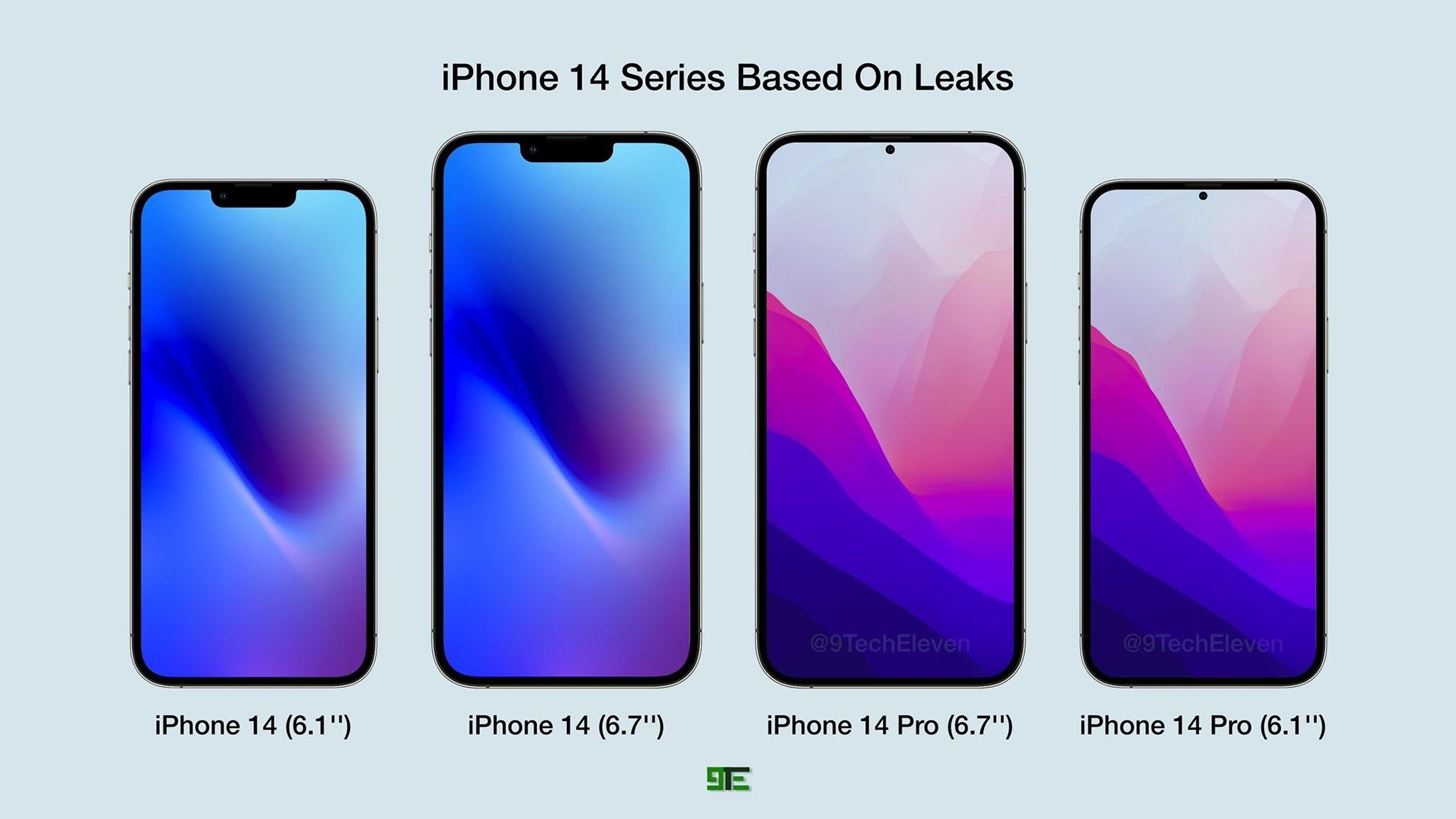
Security
Apple removed Touch ID in favor of Face ID starting with the iPhone X in November 2017, but it had been rumored that all the iPhone 14 models — or just the 14 Max ones — would incorporate both biometric systems. However, Kuo recanted that rumor and said we will most likely not see a Touch ID/Face ID combo until 2023 with the iPhone 15 series.
Additionally, Face ID may still not be under the screen and instead will have a small pill-like shape cutout for the infrared scanner.
- Touch ID: no
- Face ID: yes
Body Design
This year, we expect Apple to clean up the iPhone’s current design by eliminating some annoyances, mainly the notch and rear camera bump.
The notch has been around since the iPhone X, and many customers have wanted Apple to remove it. The iPhone 14 series is anticipated to be the first notch-less iPhone in response. Instead, the smartphone might include a hole punch for the front camera.
According to Apple leaker DylanDKT, Apple may bring a pill-shaped cutout to replace the front camera and light sensor. Other rumors indicate a combination of a hole punch for the camera and a pill shape for the light sensors. Current leaks confirm these rumors showing that the iPhone 14 Pro and iPhone 14 Pro Max will feature the “i” shaped cutouts.
Another significant update is that Prosser expects the iPhone 14 series to retire the large camera bump on the back of the phone, which has been growing bigger every year. As time goes on, that seems more and more unlikely.
14 Pro and 14 Pro Max pic.twitter.com/39TMqVTFVc
In March 2022, prominent leaker, Max Weinbach, shared renders of the iPhone 14 Pro and iPhone 14 Pro Max, indicating that we will see a more prominent camera bump on the Pro iterations of the phone. Five days later, Kuo confirmed this leak, saying we will see a larger bump on the 2022 series iPhone. In April, we saw molds of the iPhone 14 series, indicating an increase in camera bump size.
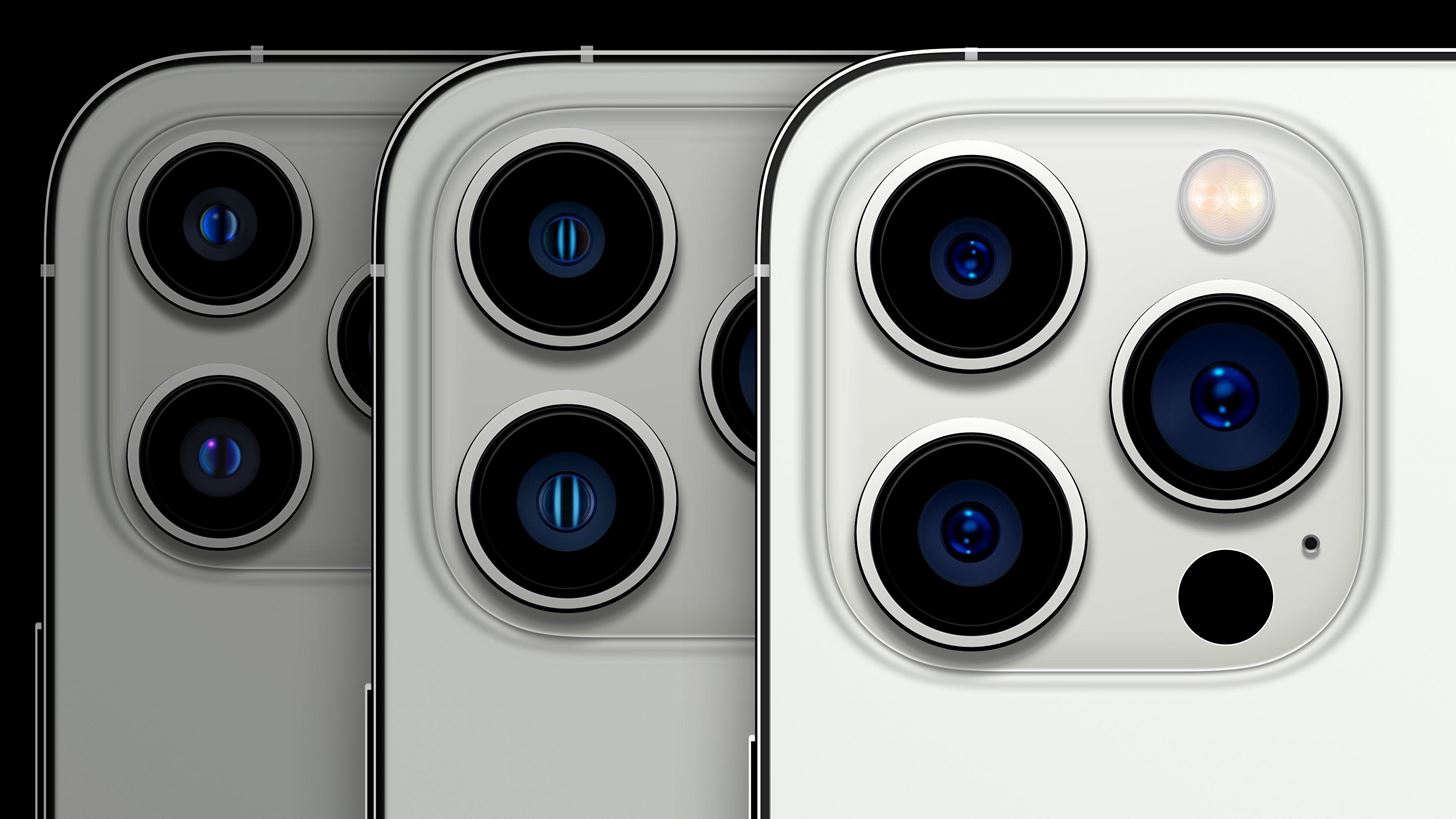
For those upgrading from the iPhone 13 series to an iPhone 14 series model, there’s one big question: Will my current case fit on the iPhone 14 model? It’s hard to know exactly for sure. It is unlikely based on the mockups and renders we’ve seen, especially on the Pro models. For instance, in the Weinbach renders above, the iPhone 14 Pro and iPhone 14 Pro Max seem to be slightly smaller because of the reduced bezel size.
- Notch: only for iPhone 14, 14 Max
- Notch-less: only for iPhone 14 Pro, 14 Pro Max (as a hole punch and pill-shaped cutout)
- Camera bump: likely bigger on Pro series
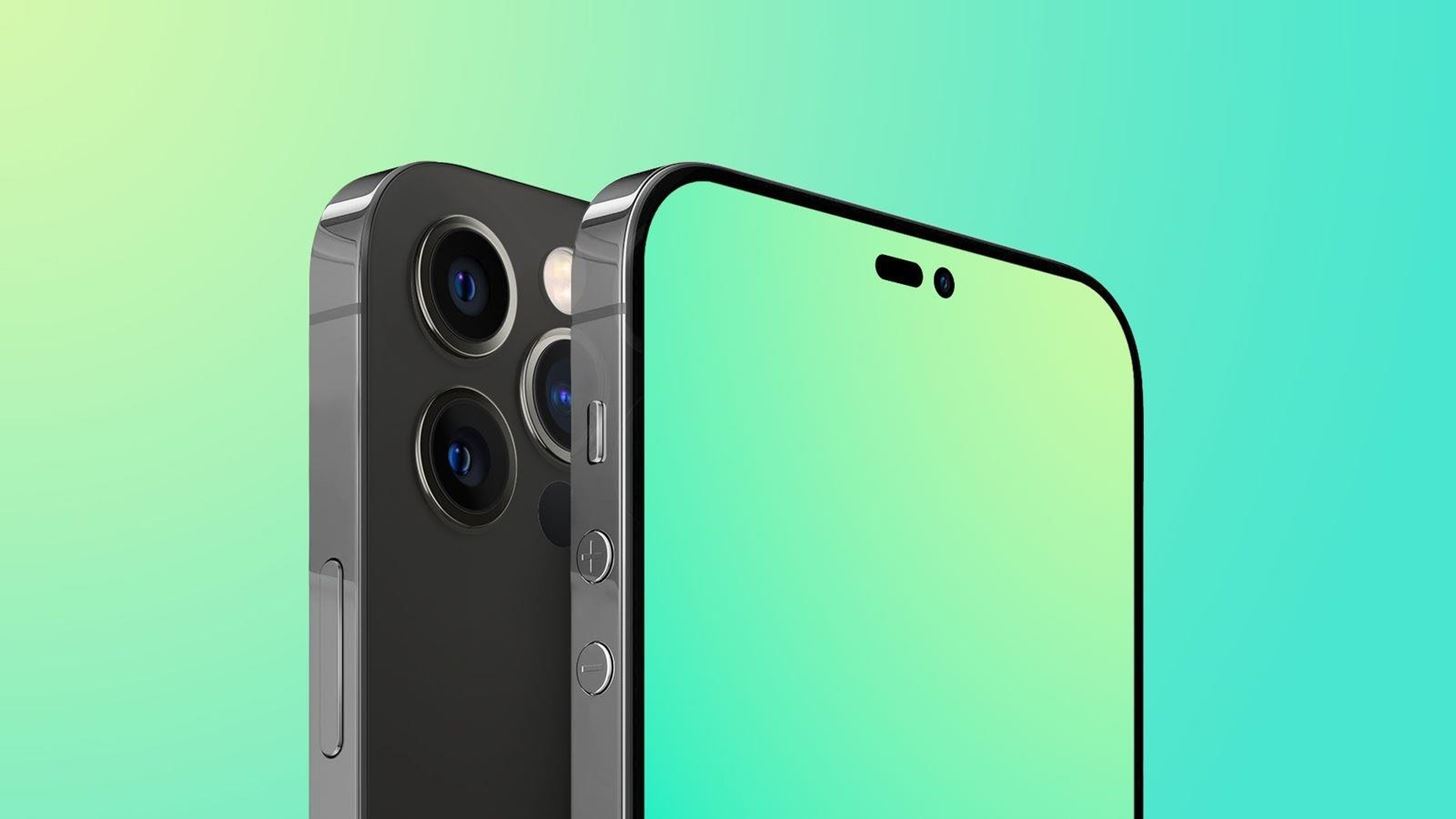
Apple reintroduced the boxy iPhone frame with the iPhone 12 series in October 2020. The iconic look brings back the days of the iPhone 4 and 5 series. Apple introduced clean curves on the iPhone 6 and didn’t let up on that design until the iPhone 12 models.
Most leaks anticipate that Apple will keep the boxy frame with the iPhone 14. However, according to Prosser, Apple will also be changing the volume buttons on the side to a more circular shape.
- Design: box-like frame, similar to iPhone 12 and 13 series
- Colors: unknown colors
- Volume buttons: circular
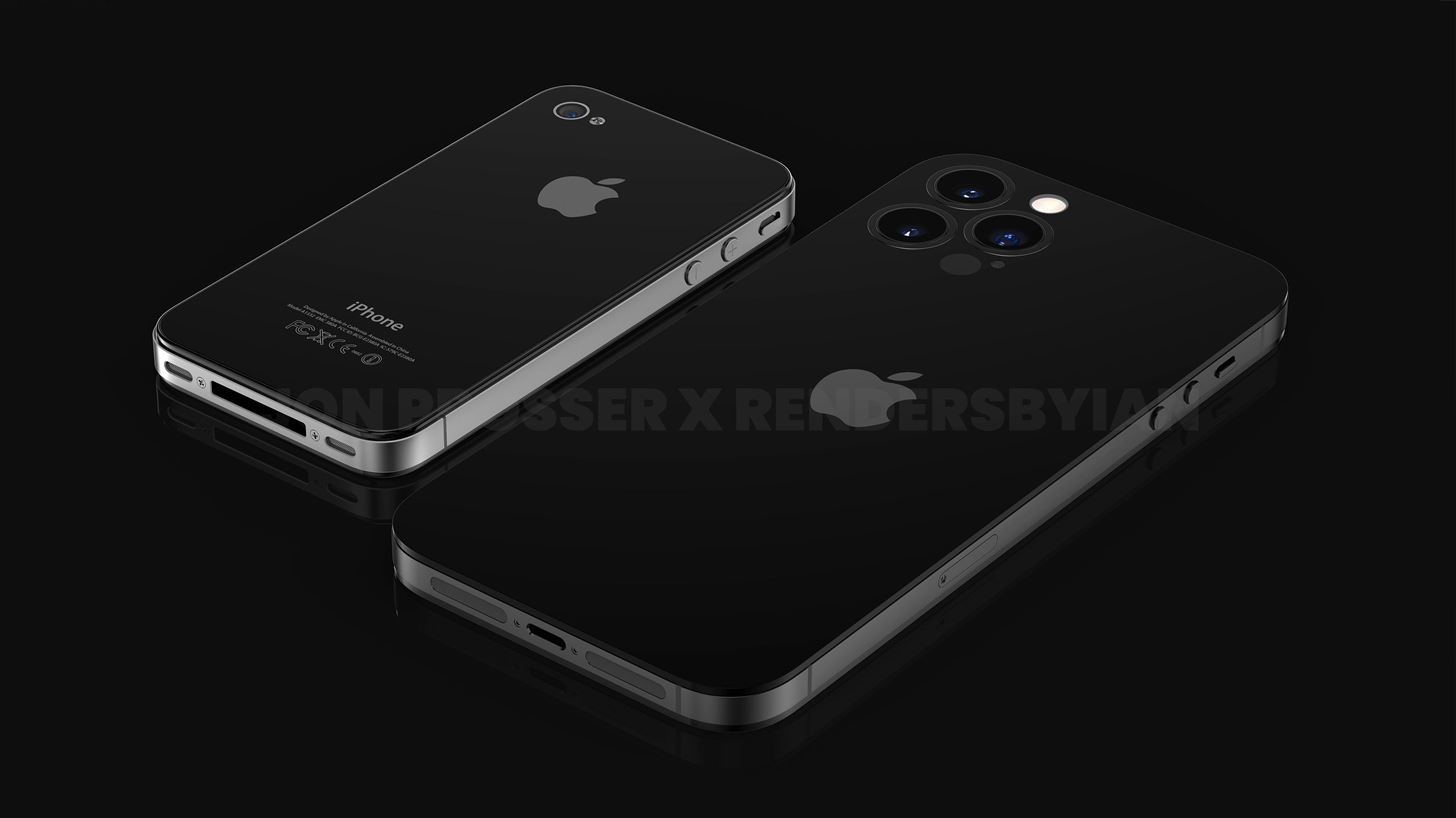
Materials
Apple has been using a stainless steel or aluminum frame since the existence of the iPhone. According to Prosser and an investor report by JP Morgan Chase, we anticipate Apple to adopt a high-end titanium alloy chassis design with the iPhone 14 series.
Titanium has its pros and cons. For example, titanium is quite a bit harder than aluminum, making it more scratch-resistant, and it’s about 40% of stainless steel’s weight. However, titanium is prone to gathering fingerprints, making it unappealing to consumers. To help this issue, according to a patent found by Patently Apple, Apple has been working on an oxide film anti-fingerprint coating.
- Stainless steel frame: only for iPhone 14, 14 Max
- Stainless steel frame coating: physical vapor deposition (PVD) process
- Titanium frame: only for iPhone 14 Pro, iPhone 14 Pro Max
- Titanium frame coating: oxide film anti-fingerprint coating
- Back: glass
- Front: Corning Ceramic Shield glass
- Front coating: fingerprint-resistant oleophobic process
Display
Last year, Apple adopted the low-temperature polycrystalline oxide (LTPO) display for the iPhone 13 Pro models. Apple calls this display its ProMotion display which allows the company to add variable frame refresh rates, including as low as 24 Hz and up to 120 Hz. Apple opted not to include LTPO in the iPhone 13 and iPhone 13 mini models. However, we expect that to change with the iPhone 14 series.
Apple analyst Jeff Pu suggests that all smartphones in the iPhone 14 series will include LTPO and variable refresh rates.
- Screen size: 6.1 inches for iPhone 14, 14 Pro; 6.7 inches for iPhone 14 Max, iPhone 14 Pro Max
- Display type: OLED, Super Retina XDR
- Display backplane: LTPO
- ProMotion: yes
- Refresh rate: variable, 24 Hz–120 Hz
- Screen resolution: 2532 by 1170 (iPhone 14, 14 Pro); 2778 by 1284 (iPhone 14 Max, 14 Pro Max)
- Pixel density:460 (iPhone 14, 14 Pro); 458 ppi (iPhone 14 Max, 14 Pro Max)
- 3D Touch: no
- Haptic Touch: yes
- HDR: Dolby Vision, HDR10, and HLG
- Minimum brightness: unknown
- Typical maximum brightness: 800 nits (iPhone 14, 14 Max); 1000 (iPhone 14 Pro, 14 Pro Max)
- HDR maximum brightness: 1200 nits
- Contrast ratio: 2,000,000:1 contrast ratio (typical)
- Screen-to-body ratio: likely 86% (iPhone 14, 14 Pro); likely 87.4% (iPhone 14 Max, 14 Pro Max)
- Aspect ratio: 19.5:9
- Color temperature: unknown
- Notch: see “Design” section above
Cameras
Last year, the cameras on all four variations of the iPhone 12 got very reasonable updates. However, several different sources — including Kuo, TrendForce, and Pu — have supported the idea of Apple giving a massive upgrade to the camera system on the iPhone 14 Pro and 14 Pro Max.
Rear Camera
The iPhone 14 Pro and 14 Pro Max rear cameras are rumored to be updated to 48 megapixels from the current 12 megapixels. With a process called pixel binning, the new cameras will use 48 megapixels in bright conditions and 12 megapixels in low-light conditions, a process already available on the Samsung S21 Ultra.
Kuo also expects the Pro cameras to record up to 8K video.
However, a newer report from known leaker It’s Fat states that we will not see a camera upgrade. Instead, we will see the same 12 MP camera system from the iPhone 13 Pro. Apple has used 12 MP rear cameras on all iPhone models since the iPhone 6s.
For Photos:
- Resolution (iPhone 14 Pro, 14 Pro Max): likely 48 MP (in bright conditions), 12 MP (in low-light conditions), but possibly just 12 MP (in all conditions)
- Resolution (iPhone 14, 14 Max): likely 12 MP in all conditions
- Aperture: unknown
- Optical Zoom In: likely 3x for iPhone 14 Pro, 14 Pro Max only
- Optical Zoom Out: likely 2x
- Digital Zoom: up to 5x (for iPhone 14, 14 Max); up to 15x (for 14 Pro, 14 Pro Max)
- Flash: True Tone flash with Slow Sync
- Image stabilization: sensor-shift optical image stabilization
- RAW support: Apple ProRAW for 14 Pro, 14 Pro Max only
- Lens cover: likely sapphire crystal
- Object detection: likely bodies, faces
- Formats: HEIF, JPEG (for all models); Apple ProRAW (for 14 Pro, 14 Pro Max)
- HDR: Smart HDR 4
- Portrait lighting: yes, with six effects
- Night mode: yes
- Night mode portraits: only for iPhone 14 Pro, 14 Pro Max
- Panorama: yes
- Pre-filters: Photographic Styles
- Other: burst mode, geotagging, red-eye correction, lens correction (ultra-wide), wide color capture for photos and Live Photos, Deep Fusion, 100% focus pixels (wide)
For Video:
- Resolutions: 720p, 1080p, 4K, HDR with Dolby Vision (for all models); 8K (for iPhone 14 Pro, 14 Pro Max)
- 720p resolution: 30 fps
- 1080p HD resolution: 25 fps, 30 fps, 60 fps
- 4K resolution: 24 fps, 25 fps, 30 fps, 60 fps
- 8K resolution: up to 30 fps (for iPhone 14 Pro, 14 Pro Max only)
- HDR with Dolby Vision: up to 4K at 60 fps
- ProRes: up to 4K at 30 fps (for iPhone 14 Pro, 14 Pro Max only)
- Slow motion: 1080p at 120 fps or 240 fps
- Time-lapse: yes, with stabilization and Night mode
- Lidar scanner: for iPhone 14 Pro, 14 Pro Max only
- Photos: 8 MP stills while recording 4K
- Optical zoom in: 3x for iPhone 14 Pro, 14 Pro Max only
- Optical zoom out: 2x
- Digital zoom: up to 9x (for iPhone 14 Pro, 14 Pro Max); up to 3x (for iPhone 14, 14 Max)
- QuickTake: yes
- Flash: True Tone flash with Slow Sync
- Image stabilization: sensor-shift optical image stabilization for video
- Lens cover: likely sapphire crystal
- Object detection: likely bodies, faces
- Audio: stereo with audio zoom
- Formats: H.264, H.265 HEVC (for all models); ProRes (for iPhone 14 Pro, 14 Pro Max)
- Other: likely playback zoom, continuous autofocus, extended dynamic range for up to 60 fps
Front Camera
We are not expecting any changes with the front-facing TrueDepth camera.
- Type: TrueDepth
- Resolution (photos): 12 MP
- Resolution (videos): likely 1080p and 4K
- 720p resolution (videos): 30 fps
- 1080p HD resolution (videos): 25 fps, 30 fps, 60 fps
- 4K resolution (videos): 24 fps, 25 fps, 30 fps, 60 fps
- 8K resolution (videos): not likely
- HDR with Dolby Vision (videos): up to 4K at 60 fps
- ProRes (videos): up to 4K at 30 fps (for iPhone 14 Pro, 14 Pro Max only)
- Cinematic mode (videos): 1080p at 30 fps
- Slow motion (videos): up to 1080p at 120 fps
- Aperture: likely ƒ/2.2
- Zoom: unknown
- QuickTake: yes
- Flash: Retina Flash
- Image stabilization (videos): cinematic video stabilization
- HDR (photos): Smart HDR 4
- Portrait mode: yes, with advanced bokeh and Depth Control
- Portrait Lighting: yes, with six effects
- Night mode: yes
- RAW support: Apple ProRAW (for iPhone 14 Pro, 14 Pro Max only)
- Object detection: likely bodies, faces, winks, tongues
- Formats (photos): HEIF, JPEG (for all models); Apple ProRAW (for iPhone 14 Pro, 14 Pro Max)
- Formats (videos): H.264, H.265 HEVC (for all models); Apple ProRes (for iPhone 14 Pro, 14 Pro Max)
- Time-lapse: yes, with Night mode
- Pre-filters: Photographic Styles
- AR features: Animoji, Memoji
- Other: likely Burst mode, Deep Fusion, lens correction, wide color capture for photos and Live Photos, extended dynamic range for video up to 30 fps
Processor
The new iPhone comes with an improved processor every year, and for the iPhone 14 series, we expect to see the A16 Bionic chip.
However, according to Kuo, we may see the A15 Bionic chip stay in the iPhone 14 and the iPhone 14 Max. 9to5Mac expands on this idea, saying that Apple may call this new chip the A15X Bionic chip.
We anticipate Apple to build the new A16 Bionic chip on Taiwan Semiconductor Manufacturing Company’s (TSMC) “NP4 process,” also named the 4-nanometer process. The new technique takes up less physical space, has improved performance, and increases enhanced energy efficiency.
As for the GPU, Apple upgraded it to include five cores last year. However, the fifth core is disabled in the standard iPhone 13 and iPhone 13 mini. 9to5Mac states that Apple will turn on that fifth core for all iPhone 14 models in the A16 Bionic and A15X Bionic chips.
Some rumors from Kuo in 2021 also suggest that we’ll see a new vapor chamber thermal system. The new thermal system is designed to keep the devices cool under high stress. It is unknown whether or not this feature will be implemented in the 2022 iPhone. This system is already used by Samsung, Sony, Razer, and LG in newer flagship phones. A similar system was used in 2021’s 14-inch and 16-inch MacBook Pros.
- Processor: A16 Bionic (iPhone 14 Pro, iPhone 14 Pro Max), A15X Bionic (iPhone 14, iPhone 14 Max)
- Chip size: likely 4 nm
- CPU frequency: unknown
- CPU cores: 6-core (2 high-performance, 4 energy-efficient)
- System cache: 32 MB
- GPU: Apple-designed (unknown model)
- GPU cores: 5-core
- NPU cores: 16-core
- Cooling system: possible vapor chamber cooling system
Connectivity
Apple upgraded the iPhone to support Wi-Fi 6 in September 2019 with the iPhone 11. With the Wi-Fi 6E standard starting to become widely supported by routers, many hope the next iPhone adds support for Wi-Fi 6E, and according to Kuo, we can anticipate Apple featuring Wi-Fi 6E connectivity in the iPhone 14 models.
Wi-Fi 6E adds support for an extra bandwidth called 6 GHz. This band allows for more airwave channels for less interference and low latency, improving Wi-Fi performance.
- Wi-Fi: likely Wi-Fi 6E
- Bluetooth: 5.0
- NFC: yes, with reader mode
- Spatial awareness: Ultra Wideband chip
- Port: Lightning, though USB-C is possible
- Other: iBeacon microlocation, AirPlay, AirDrop
- Transit: Express Cards with power reserve
Apple added a 5G modem to iPhones in October 2020. The iPhone 12’s modem was one of the best on the market — the Qualcomm Snapdragon X55 5G Modem-RF System.
With the iPhone 13, Apple upgraded the modem to the updated Qualcomm Snapdragon X60 5G Modem-RF System. The new Snapdragon X60 modem included aggregated high- and mid-band support. This support brought better 5G performance and supported better battery life. However, 5G technology has advanced quite a bit since then.
While we don’t expect Apple to use its own 5G modem quite yet, the company will likely upgrade to Qualcomm’s Snapdragon X65 5G Modem-RF System. This modem is the first 10 Gigabit 5G Modem and Antenna system bringing improved battery efficiency and enhanced coverage for all 5G frequencies. Additionally, it supports all commercialized high-band (mmWave) frequencies, including the newest n259 (41 GHz) band.
The most significant upgrade the new modem brings is support for emergency satellite communications. This feature will allow users to send emergency messages via satellite instead of cell or Wi-Fi signals, allowing users in remote areas to get help right away during emergencies. According to 9to5Mac, Apple internally codenames the feature “Stewie.”
According to reputable leaker and Apple analyst Mark Gurman, along with short messages, users will be able to send their location, Medical ID, and alerts to emergency contacts with these messages. Messages will show in gray instead of blue or green.
- Cellular modem: Snapdragon X65 5G Modem-RF System
- Emergency satellite communication: likely
- LTE: Gigabit LTE with 4×4 MIMO
- 5G: 10 Gigabit 5G with sub-6 GHz and mmWave
- Spatial awareness: Ultra Wideband chip
As for SIM technology, Apple includes a physical SIM card slot in the current iPhone lineup. You can also connect your iPhone to a network using an eSIM if you do not have a physical SIM card for a carrier. It’s unlikely, but physical SIM card support may change with the iPhone 14.
Some rumors state that Apple is looking to remove the SIM card slot from the iPhone. However, other sources are stating it will be an option but not adopted by all iPhone models.
- SIM Card: dual Nano-SIM card tray, but eSIM only is possible
Charging/Data Port
There are so many rumors floating around about the current Lightning port. Since Apple introduced MagSafe with the iPhone 12 and removed the headphone jack in 2016, rumors have been roaming about the possibility of Apple removing the ports altogether. It was revealed by an FCC filing found by MacRumors that the Apple Watch Series 7 has a 60.5 GHz module for data transfer, verifying Apple is working on making the iPhone portless. Also, with the European Union mandating all smartphones adopt the USB-C port, rumors have spread about the possibility of bringing USB-C to the iPhone.
However, other than this circumstantial evidence, we do not have any rumors or leaks to prove that Apple will change the port. If we see some change, at least one device will likely keep the Lightning port. Kuo confirms this rumor, believing that the first iPhone to adopt the USB-C port will be the iPhone 15 (the model released in 2023).
And while there are no sources to back it up, we can expect that Apple will continue improving its MagSafe charging technology.
- Charing/data port: Lightning, but USB-C is possible
- Wireless charging: Qi standard (up to 7.5 W)
- MagSafe wireless charging: up to 15 W
- Wired charging: up to 20 W with USB-C cable or USB PD
- Fast charging: wired with 20 W adapter or higher; wireless with 15 W MagSafe charger
Battery
We saw a massive upgrade with the battery in the iPhone 13 series. For example, the iPhone 13 Pro Max has a 4,352 mAh battery compared to the 3,687 mAh battery in the iPhone 12 Pro Max. So it’s just natural that we look for a similar upgrade in this year’s iPhone.
Credible leaker Ross Young has stated that we may see another battery upgrade. However, he does not say how much bigger.
- Battery: rechargeable lithium-ion
- Capacity: same or more than the iPhone 13 series
Storage Options
Last year, we saw Apple add a 1 TB option to the iPhone 13 Pro models. That creates traction for rumors to spread about another storage option. While there aren’t any credible leaks about it, we anticipate that option to be a 2 TB version for the iPhone 14 Pro and iPhone 14 Pro Max if the rumor comes true.
However, Apple analyst Pu believes that Apple will start the 14 Pro models at 256 GB. Interestingly, he says that Apple will start the two regular iPhone 14 models at 64 GB on the same note.
- iPhone 14: 128 GB, 256 GB, 512 GB (64 GB also possible)
- iPhone 14 Max: 128 GB, 256 GB, 512 GB (64 GB also possible)
- iPhone 14 Pro: 128 GB, 256GB, 512 GB, 1 TB (2 TB also possible, which would likely replace the 128 GB model)
- iPhone 14 Pro Max: 128 GB, 256 GB, 512 GB, 1 TB (2 TB also possible, which would likely replace the 128 GB model)
RAM
In 2020, Apple increased the RAM capacity in the iPhone 12 Pro models to 6 GB, but it decided to keep the iPhone 12 and iPhone 12 mini at 4 GB. Last year, it was the same for the iPhone 13 models.
According to Kuo, we are likely to see 6 GB RAM for each device in the iPhone 14 series. However, the iPhone 14 Pro and iPhone 14 Pro Max will get the LPDDR 5 RAM upgrade while the iPhone 14 and iPhone 14 Max will keep the iPhone 13’s LPDDR 4x.
Only two Pro models would upgrade to the A16 processor, while the 14 & 14 Max will remain the A15. All four new models will likely come with 6GB RAM, with the difference being LPDDR 5 (14 Pro & 14 Pro Max) vs. LPDDR 4X (14 & 14 Max). https://t.co/tHcszIz6gX
LPDDR stands for Low-Power Double Data Rate. It’s the type of RAM featured in mobile phones and many different laptops. LPDDR 5 brings 1.5 times faster RAM speed than LPDDR 4x with the possibility of using slightly less power.
Some rumors suggest that Apple plans to update all models with an extra 2 GB. However, Pu disagrees, saying that because of supply changes, only the two non-Pro models will be getting an upgrade.
- iPhone 14: 6 GB LPDDR 4x
- iPhone 14 Max: 6 GB LPDDR 4x
- iPhone 14 Pro: 6 GB LPDDR 5 (though 8 GB is possible)
- iPhone 14 Pro Max: 6 GB LPDDR 5 (though 8 GB is possible)
Audio
There are no solid audio rumors, so it’s likely to be the same as the iPhone 13 series.
- 3.5 mm headphone jack: no
- Stereo speakers: yes
- Mics: three total (on the rear, front, and bottom)
- Max speaker volume: unknown
Sensors
Like with audio, the sensors are likely to be the same as the iPhone 13 series.
- Sensors: GPS, barometer, accelerometer, three-axis gyroscope, proximity sensor, barometer, digital compass, Face ID (possibly also Touch ID, though more likely in the iPhone 15 series)
Software
Apple always ships its new iPhones with the company’s latest version of iOS. In this case, it would be iOS 16, which is currently in development internally. Third-party developers will likely get a preview of iOS 16 in June when WWDC happens, and the public will get access to the beta shortly after that.
- Software: iOS 16
There’s also going to be support for Wi-Fi or cellular FaceTime video calls, FaceTime audio, voice over LTE (VoLTE), Wi-Fi calling, full Siri support, and Apple Pay. A variety of language options, QuickType keyboard, autocorrection, predictive input, multilingual input, QuickPath, Siri, dictation, dictionaries, and spell check, will also be available.
Media Formats
The following audio files are likely supported: AAC-LC, HE-AAC, HE-AAC v2, Protected AAC, MP3, Linear PCM, Apple Lossless, FLAC, Dolby Digital (AC-3), Dolby Digital Plus (E-AC-3), Dolby Atmos, and Audible (formats 2, 3, 4, Audible Enhanced Audio, AAX, and AAX+) files. There will also be spatial audio playback and a user-configurable maximum volume limit.
Video playback support likely includes HEVC, H.264, MPEG-4 Part 2, and Motion JPEG, as well as High Dynamic Range with Dolby Vision, HDR10 content, and HLG.
There will likely be up to 4K HDR AirPlay for mirroring, photos, and video out to 2nd generation Apple TV or later, as well as an AirPlay 2–enabled smart TV. Video mirroring and video out will support up to 1080p through Lightning Digital AV Adapters and Lightning to VGA Adapters.
Basics
The iPhone 14 design is similar to last year’s (at least for three models), so there won’t be too much of a change. There is a rumored difference in size on the Pro series models, but it’s so tiny you can barely tell on an imperial (inches) scale. However, we do not expect to see any changes in the entry-level iPhone 14. We don’t expect the water resistance rating to change.
- iPhone 14 height: 5.78 inches (146.7 mm)
- iPhone 14 width: 2.82 inches (71.5 mm)
- iPhone 14 depth: 0.30 inch (7.65 mm)
- iPhone 14 weight: unknown
- iPhone 14 Max height: 6.33 inches (160.8 mm)
- iPhone 14 Max width: 3.07 inches (78.1 mm)
- iPhone 14 Max depth: 0.30 inch (7.65 mm)
- iPhone 14 Max weight: unknown
- iPhone 14 Pro height: 5.8 inches (147.46 mm)
- iPhone 14 Pro width: 2.81 inches (71.45 mm)
- iPhone 14 Pro depth: 0.30 inch (7.85 mm)
- iPhone 14 Pro weight: unknown
- iPhone 14 Pro Max height: 6.32 inches (160.7 mm)
- iPhone 14 Pro Max width: 3.05 inches (77.58mm mm)
- iPhone 14 Pro Max depth: 0.30 inch (7.85 mm)
- iPhone 14 Pro Max weight: unknown
- Dust/water resistance: IP68 (max depth of 6 meters for up to 30 minutes) under IEC standard 60529
- U.S. mobile network operators: AT&T, T-Mobile, Verizon
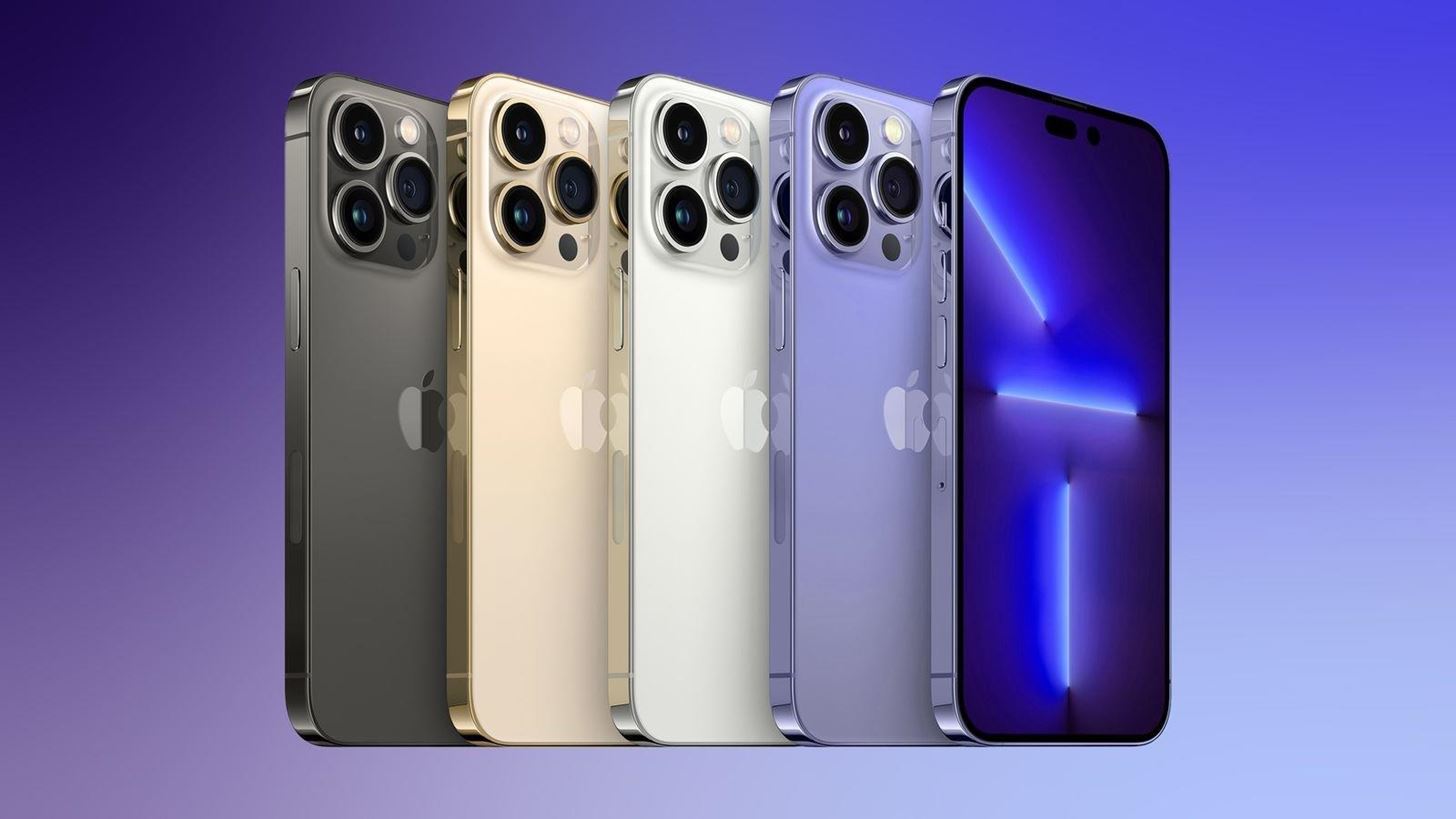
There are some rumors regarding the colors of the next iPhone. According to a sketchy leak that has since been deleted, the Pro series will be getting a different color like it has the past few years. This year, it will be a purple shade. The two entry-level iPhone 14 phones will have the same color options.
- iPhone 14 colors: Product Red, Starlight, Midnight, Blue, Pink, and Green
- iPhone 14 Max colors: Product Red, Starlight, Midnight, Blue, Pink, and Green
- iPhone 14 Pro colors: Graphite, Gold, Silver, and Purple
- iPhone 14 Por Max colors: Graphite, Gold, Silver, and Purple
The environmental operating requirements have been the same since its iPhone 7 models were released. No changes are expected.
- Operating temp: 32° to 95° F
- Nonoperating temp: –4° to 113° F
- Relative humidity: 5%–95% noncondensing
- Operating altitude: up to 10,000 feet (though could be more)
Pricing
While we usually don’t get any leaks for prices, we can make some educated guesses. We expect the three phones that will retain the same naming scheme to stay at the same price. For the new 6.7-inch iPhone 14 Max, we expect it to be $100 USD above the standard iPhone 14. Additionally, if we see a 2 TB option, we can anticipate that version to be $200 USD more than the 1 TB option.
Some sketchy leaks report that the iPhone may increase in pricing for the iPhone 14. However, until we see someone credible confirm the leak, you should take it with a grain of salt. The leak suggests an increase in price for the Pro models to cover the cost of new upgrades — such as the under-screen Face ID hardware, under-screen Touch ID, and new camera system.
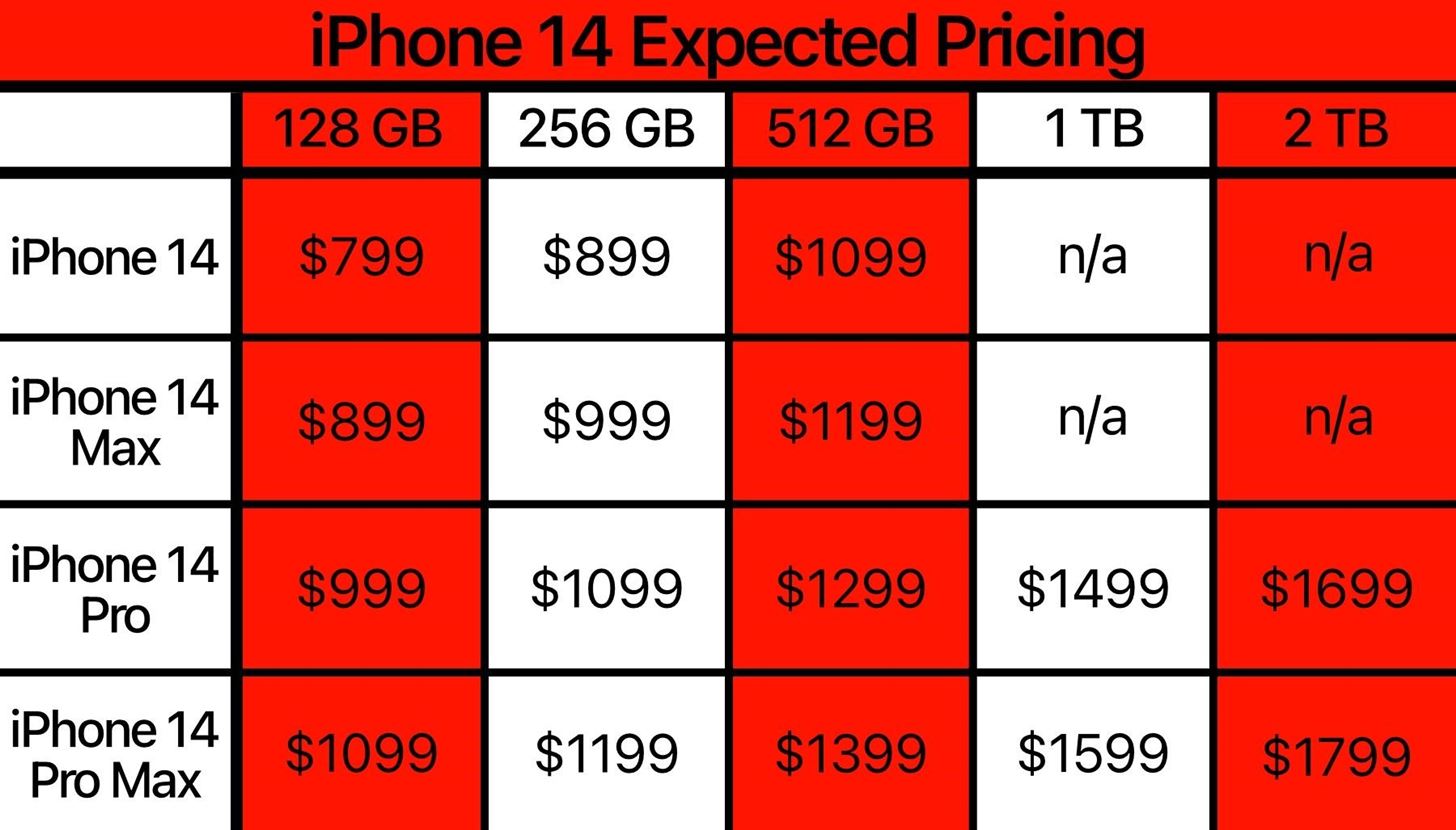
AppleCare+
Also, customers can expect to get the same one-year limited warranty and 90 days of tech support as you get with the iPhone 13 series. You will be able to extend that one-year warranty and get accidental coverage, hardware coverage, 24/7 priority access, and express replacement with AppleCare+ for two years. For an additional fee, you can get theft and loss coverage.
When looking to get AppleCare+, keep in mind that it is essentially phone insurance. There is a deductible if you need to replace the phone due to something that is your fault — such as dropping the device or water damage.
Apple did lower the cost of AppleCare+ for the iPhone 13 Pro and iPhone 13 Pro Max from $219 to $199. However, we anticipate the AppleCare+ prices to stay the same. That means standard AppleCare+ will be $149 ($7.99/mo) for the iPhone 14 and iPhone 14 Max, and $199 ($11.49/mo) for the iPhone 14 Pro and iPhone 14 Pro Max. AppleCare+ with Theft and Loss will cost $199 ($9.99/mo) and $269 ($13.49/mo), respectively.
After the two years are up for the original AppleCare+ plan, customers have an option to upgrade for another year at the same price.
- AppleCare+ for iPhone 14, 14 Max: $149 ($7.99 per month)
- AppleCare+ with Theft and Loss for iPhone 14, 14 Max: $199 ($9.99 per month)
- AppleCare+ for iPhone 14 Pro, 14 Pro Max: $199 ($9.99 per month)
- AppleCare+ with Theft and Loss for iPhone 14 Pro, 14 Pro Max: $269 ($13.49 per month)
iPhone Upgrade Program with AppleCare+
First introduced in 2015, the iPhone Upgrade Program allows customers to upgrade their iPhones every year. Nowadays, phone carriers typically will enable you to do so anyway, but carriers lock you into using them during the entire time you are paying off the phone. You have to pay off the phone in full if you want to leave a carrier. Apple’s iPhone Upgrade Program allows you to move between carriers as you please.
However, both Apple’s iPhone Upgrade Program and your phone carrier’s upgrade programs are similar in some ways. When you upgrade your phone, you trade the old one in. When you return the old phone, you do not continue to pay for it; Instead, you start paying for the new phone.
The iPhone Upgrade Program forces you to pay for AppleCare+, so this program isn’t for you if you don’t want to pay the extra amount for AppleCare+. However, if you want AppleCare+, this program bundles it together and gives you the option of Theft and Loss protection for an additional $2.91 per month.
We expect the iPhone Upgrade Program pricing to stay the same with the iPhone 14 series, meaning that prices will be the iPhone price plus the total AppleCare+ price ($149 or $199) divided by 24 months. Of course, these prices are all banking on Apple keeping the exact costs above.
- Example: iPhone 14 Pro, 128 GB is ($999 + $199) ÷ 24 = $49.91 per month
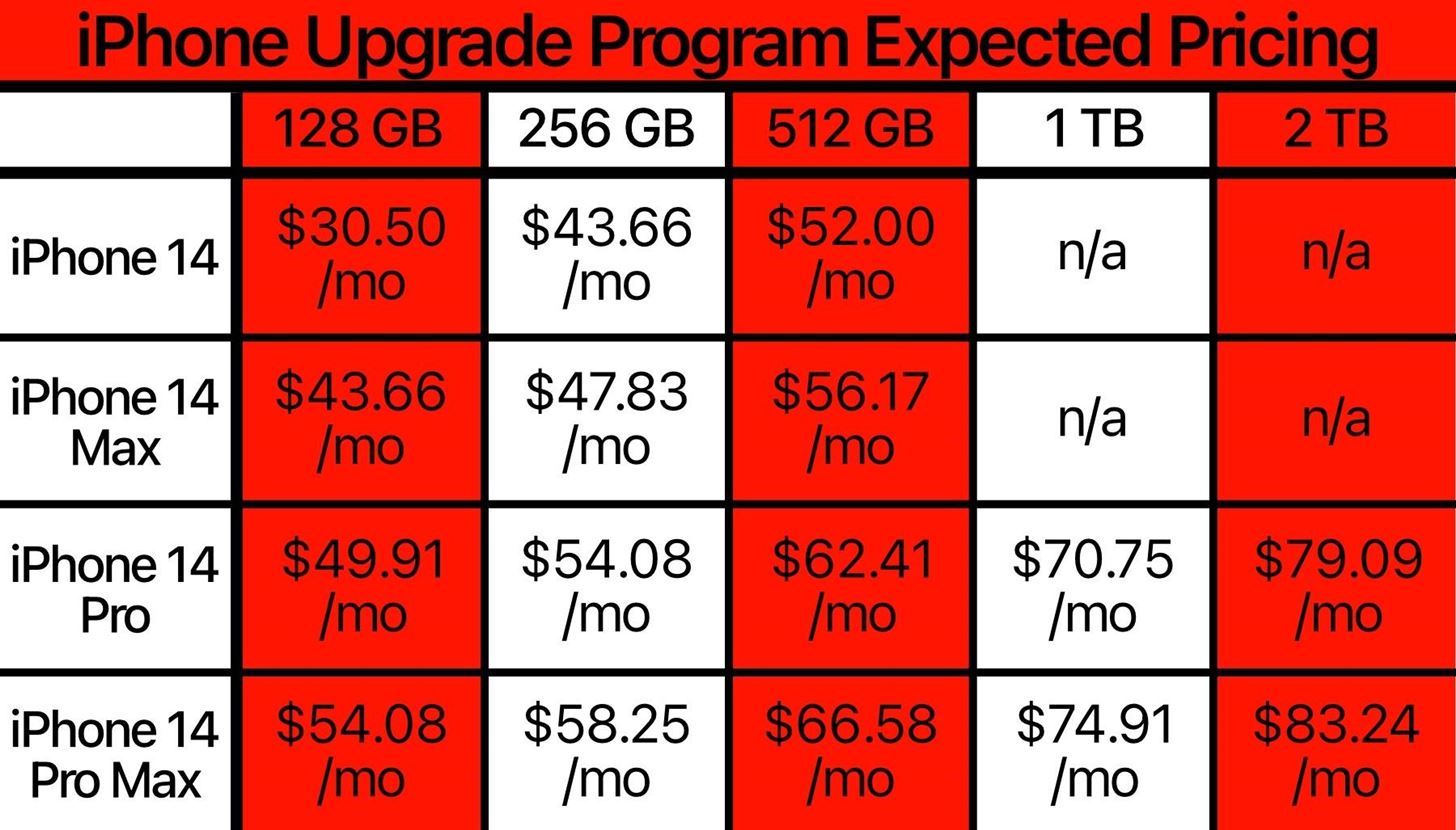
Dates
Apple does not give out release dates for the iPhone until event day. However, based on what it did last year, we can guess that Apple will hold the iPhone 14 event in the third week of September 2022. Additionally, we saw pre-order dates at the end of that same week, with the phone launch date a week after the pre-order.
However, if there are production delays like Apple had in 2020 due to the COVID-19 pandemic, we may see Apple hold back until October 2022.
- Event announcement: First or second week of September 2022
- Event: Third week of September 2022
- Pre-order: Mid-to-late September 2022
- Release: Late September 2022
Just updated your iPhone? You’ll find new emoji, enhanced security, podcast transcripts, Apple Cash virtual numbers, and other useful features. There are even new additions hidden within Safari. Find out what’s new and changed on your iPhone with the iOS 17.4 update.
“Hey there, just a heads-up: We’re part of the Amazon affiliate program, so when you buy through links on our site, we may earn a small commission. But don’t worry, it doesn’t cost you anything extra and helps us keep the lights on. Thanks for your support!”









